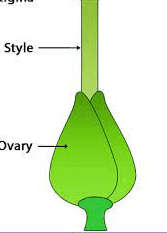The fluted pumpkin, also known as Telfairia occidentalis, is a vital vining plant native to West Africa. Beyond its delicious and nutritious leaves, the fluted pumpkin boasts a unique flower structure with a fascinating ovary, playing a critical role in the plant’s reproduction. This article delves into the scientific description of the fluted pumpkin ovary, exploring its anatomy, development, and function within the flower’s intricate dance of life.
The fluted pumpkin flower is a solitary structure, emerging from the leaf axils of the mature vine. Unlike many flowering plants with separate male and female flowers, the fluted pumpkin flower is monoecious, meaning it possesses both male and female reproductive organs within the same bloom. The female component of this system resides in the ovary, positioned at the base of the flower.
The fluted pumpkin ovary is inferior, meaning it develops below the point of attachment of the petals and sepals. This positioning gives the mature fruit, derived from the ripened ovary, a characteristic elongated shape with a characteristic “fluted” appearance.
The ovary itself is typically described as syncarpous, indicating the fusion of several carpels, the individual units that make up the female reproductive structure in flowering plants. The number of fused carpels in the fluted pumpkin ovary can vary, typically ranging from three to five.
Within each carpel lies a chamber containing ovules, the potential seeds waiting to be fertilized. These ovules are anatropous, meaning they become inverted during development, with the micropyle, the opening that receives pollen, positioned closest to the ovary wall. The number of ovules per carpel can also vary, but it’s generally on the lower side compared to some other flowering plants.
Following successful pollination, where pollen reaches the stigma, the tip of the carpel, fertilization occurs. This triggers a cascade of cellular changes within the ovule, initiating the development of the embryo and seed coat. The ovary wall, meanwhile, begins to enlarge and mature, accumulating nutrients and transforming into the fleshy fruit we know as the fluted pumpkin.
The mature fluted pumpkin fruit, technically a pepo, is a type of berry with a tough rind. Unlike the young leaves consumed as a vegetable, the fruit itself is not typically eaten. However, the seeds housed within the mature ovary are a valuable source of protein and fat. These seeds can be further processed to extract oil with potential culinary or cosmetic applications.
In conclusion, the fluted pumpkin ovary plays a critical role in the plant’s reproductive success. Its inferior position, syncarpous nature, and variable number of ovules contribute to the unique characteristics of the fluted pumpkin fruit. Understanding the scientific intricacies of the ovary sheds light on the fascinating world of plant reproduction and the vital role the fluted pumpkin plays in West African cuisine and culture.
The Economic Importance and Uses of Fluted Pumpkin Ovary

The fluted pumpkin, also known as Ugwu (Nigeria) or African melon, is a valuable vine crop native to West Africa. Its economic importance stems from various uses associated with its ovary, seeds, and leaves. Here are 18 economic benefits and applications:
1. Food Source: The fluted pumpkin ovary, fleshy and green, is the primary edible part. It’s consumed in stews, soups (e.g., Egusi soup), and sauces, providing dietary fiber, vitamins, and minerals.
2. Vegetable Industry: Fluted pumpkin is a major staple vegetable crop in West Africa, contributing significantly to food security and income generation for farmers.
3. Nutritional Value: The ovary is rich in vitamins A, C, E, and iron, promoting healthy vision, immunity, and blood cell production.
4. Dietary Fiber: The ovary is a good source of dietary fiber, aiding digestion and gut health.
5. Seed Oil: Fluted pumpkin seeds contain oil suitable for cooking and cosmetics due to its healthy fatty acid profile.
6. Animal Feed: The pulp remaining after seed extraction is used as livestock feed, reducing reliance on commercial feeds.
7. Seed Processing: Fluted pumpkin seed processing creates jobs in shelling, cleaning, and packaging for local markets.
8. Seed Sales: Fluted pumpkin seeds are sold as snacks and for planting, generating income for farmers and seed companies.
9. Traditional Medicine: In some regions, the ovary is used in traditional medicine for treating ailments like coughs and stomach disorders. While scientific validation is ongoing, it highlights potential future applications.
10. Environmental Benefits: Fluted pumpkin cultivation helps maintain soil fertility and improves land use efficiency.
11. Weed Suppression: The fast-growing vines suppress weeds, reducing the need for herbicides and promoting sustainable farming practices.
12. Intercropping: Fluted pumpkin can be intercropped with other vegetables like maize, maximizing land use and yield.
13. Export Potential: Fluted pumpkin has increasing export potential to meet the growing demand for African vegetables in global markets.
14. Income Generation: Fluted pumpkin cultivation provides a source of income for smallholder farmers, contributing to rural economic development.
15. Job Creation: The fluted pumpkin industry creates jobs in farming, processing, transportation, and marketing.
16. Cultural Significance: Fluted pumpkin holds cultural significance in West Africa, featuring in traditional dishes and ceremonies.
17. Food Security: Fluted pumpkin’s drought tolerance makes it a vital food security crop in regions prone to dry spells.
18. Sustainable Agriculture: Fluted pumpkin’s low input requirements and minimal pest problems promote sustainable agricultural practices.
Read Also General Features of Ruminant Animals
The Products and By-products That Can Be Derived From Fluted Pumpkin Ovary

1. Edible Ovary: The primary product is the young ovary, consumed fresh or cooked in various dishes.
2. Seeds: Seeds are hulled and roasted for consumption as snacks or used for oil extraction.
3. Seed Oil: Fluted pumpkin seed oil is a valuable cooking oil and has potential applications in cosmetics due to its beneficial fatty acid content.
4. Seed Cake: The leftover pulp after seed oil extraction can be used as livestock feed, reducing waste.
5. Ash: Traditionally, burnt fluted pumpkin leaves produce ash used as a natural soap or salt substitute.
6. Fertilizer: Composted fluted pumpkin vines and leaves can be used as a nutrient-rich fertilizer for other crops.
7. Biofuel: Research suggests fluted pumpkin seeds have potential for biofuel production, promoting renewable energy sources.
8. Medicine: Preliminary studies explore the ovary’s potential use in traditional medicine for coughs and stomach issues. Further research is needed.
9. Dietary Supplements: Fluted pumpkin seed oil’s nutritional profile makes it a potential source for dietary supplements.
10. Cosmetics: The seed oil’s properties might be beneficial in cosmetic formulations for skin and hair care.
11. Industrial Applications: The potential use of fluted pumpkin oil in industrial applications like lubricants or bioplastics is under exploration.
12. Food Additives: Fluted pumpkin extracts might be used as natural food additives due to their potential antioxidant and antimicrobial properties.
13. Vermicomposting: Fluted pumpkin residues can be used in vermicomposting for breeding earthworms to create high-quality vermicompost.
14. Biodegradable Packaging: Fluted pumpkin biomass might be suitable for developing biodegradable packaging materials.
Read Also Feeding Materials for Ruminant Animals
Frequently Asked Questions (FAQs) About Fluted Pumpkin Ovary

1. What is the best time to plant fluted pumpkin?
Fluted pumpkin thrives in warm, humid conditions. The ideal planting time is typically at the beginning of the rainy season (around April or May in West Africa) to ensure sufficient moisture for germination and growth.
2. How long does it take for fluted pumpkin ovary to mature?
The fluted pumpkin ovary matures relatively quickly, within 6-8 weeks after planting. However, harvesting can begin earlier for smaller, tender ovaries preferred in some dishes.
3. How can you tell if a fluted pumpkin ovary is ripe?
A ripe fluted pumpkin ovary should be firm to the touch with a vibrant green color. Avoid ovaries with yellowing or blemishes, indicating possible spoilage.
4. How to store fluted pumpkin ovary?
Fresh fluted pumpkin ovary should be stored in the refrigerator in a breathable container for up to a week. Blanching or drying techniques can extend the shelf life for several months.
5. Are there any side effects to consuming fluted pumpkin ovary?
Fluted pumpkin ovary is generally safe for consumption. However, individuals with allergies to cucurbits (gourds, squashes) should exercise caution.
6. Can fluted pumpkin ovary be grown outside of West Africa?
Fluted pumpkin prefers warm and humid climates. It can potentially be grown in similar conditions elsewhere, but it might require specific care depending on the local environment.
7. What are the challenges associated with fluted pumpkin cultivation?
Fluted pumpkin can be susceptible to pests like beetles and fungal diseases. Storage after harvest can also be challenging due to its perishable nature.
8. Is there any research on the medicinal properties of fluted pumpkin ovary?
Yes, some studies are exploring the potential use of fluted pumpkin ovary in traditional medicine for coughs and stomach disorders. However, more scientific evidence is needed for conclusive medicinal claims.
9. Where can I find fluted pumpkin ovary outside of West Africa?
Fluted pumpkin is becoming increasingly available in some African grocery stores or online retailers in regions with large West African diaspora communities.
10. What are some alternative names for fluted pumpkin ovary?
Fluted pumpkin ovary is also known as Ugwu (Nigeria), African melon seed, or simply fluted gourd.
Read Also Low-Maintenance Plants for Beginners
